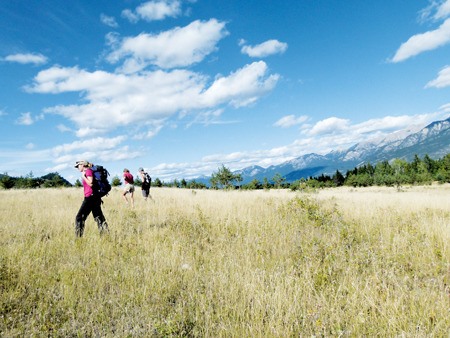Through much work and the collaborative efforts of other groups and organizations, the Nature Conservancy of Canada (NCC) has secured the long-sought Marion Creek Benchlands as a protected conservation area.
“It’s awesome, for one, and the first chance I’ve had to see real conservation hit the ground. People have been working hard for the past 25 years to see this through,” said Nancy Newhouse, NCC program manager.
The Benchlands is a 504 acre (or 204 hectare) grassland just above Columbia Lake.
The Benchlands host a number of unique species of birds, plants and other wildlife, and feature an assortment of different habitats for these creatures to flourish. Of the species in the area, 30 per cent are at risk in British Columbia.
The Benchlands value only increases when one looks where it is positioned.
The land sits between Thunder Hill Ranch (secured by the NCC in 2004) and McKersie covenant lands, and the Columbia Lake – Westside property (secured by the Nature Trust of BC in 1998).
With the Benchlands now forever protected, the “missing piece of the puzzle” has been added, completing a connected and conserved area that can now act as a safe and unthreatened corridor for many different species, including bears.
The conservation of the Benchlands also brings the total amount of land protected in the Columbia Valley by the NCC to over 6,400 acres (or 2,600 hectares).
The Benchlands were secured for $1.7 million, which includes both the purchase price and a portion of the funds needed for further conservation and planning efforts.
To celebrate the acquisition, the NCC invited the many groups who helped to make the Benchlands’ protection a reality to a barbecue and walking tour of the grasslands.
“The partnership here is the real story, so many people made this happen,” said Newhouse.
Some of the groups and organizations involved in assisting the NCC with their cause are the Columbia Basin Trust, the East Kootenay Wildlife Association, the Fish and Wildlife Compensation Program, the Habitat Conservation Trust Foundation, the Government of Canada’s Natural Areas Conservation Program, and the Regional District of East Kootenay (RDEK)’s Columbia Valley Local Conservation Fund.
“One of the things the Foundation does is secure important conservation lands, it’s an activity we’ve done for 30 years,” said Winifred Kessler, chair of the board for the Habitat Conservation Trust Foundation.
“This was a great opportunity. It’s highly valuable land with a very good committee of many partner groups working together. It was an ideal project for us. It’s a piece of the puzzle, it’s a larger piece of conservation land that creates connectivity among habitats.”
The walking tour visited the Benchlands and were given a first-hand opportunity to see the grasslands, wetlands, and the ridge, now forever protected in its natural, beautiful form.
From this point forward, the NCC will be working to keep the land managed and conserved through a variety of studies and strategies.
“Among the first things we do is a baseline inventory of the habitat types and species, and many groups helped us with that,” explained Newhouse. One unique species to the Benchlands discovered, for example, was a peculiar plant that eats insects.
Decisions still have to be made regarding management, access, fire, weeds and more to keep the Benchlands safe and secure, and a watershed assessment is in the works.
“It’s a really important project and is rewarding to have this legacy to share with future generations,” said Newhouse.
“We’re very committed to conservation, but it’s important to secure and support outdoor activity access so people can use and enjoy the land for activities as well,” added Kessler.
The Benchlands purchase was also a milestone for the RDEK’s Local Conservation Fund, which saw its first use for land acquisition with this project.
“We supported this project through the Local Conservation Fund. It’s the first time we’ve used the fund for land purchase. It was really the first opportunity to do so with the fund starting in 2009, it’s a relatively young fund and this was the first proposal for land acquisition,” said Electoral Area F Director Wendy Booth. “It’s a missing piece of the wildlife corridor, so it was an easy sell.”
Another conservation project with similar merits to the Benchlands is also on the horizon for the NCC with Lot 48, a plot of land on the other side of the Columbia River.
Like the Benchlands, it acts as a “missing piece” and wildlife corridor between two other protected areas.
At the moment, the NCC and the owners of the lot are working on a proposal agreement for the purchase, which may mean the total amount of land conserved by the NCC in the Columbia Valley will go up again in the near future.
